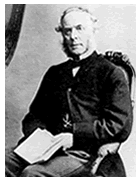Robert Fortune
| Robert Fortune | |
|---|---|
 |
|
| Born |
September 16, 1812 Kelloe, Berwickshire, Scotland |
| Died | April 13, 1880 (aged 67) |
Robert Fortune (16 September 1812 – 13 April 1880) was a Scottish botanist, plant hunter and traveller, best known for introducing tea plants from China to the Darjeeling region of India, in the Eastern Himalayas.
Fortune was born at Kelloe, Berwickshire, Scotland. He was employed in the Royal Botanic Garden Edinburgh, and later in the Horticultural Society of London's garden at Chiswick. As a result of his mission success, the British gained a large profit and they were able to manufacture tea throughout the world.
Following the Treaty of Nanjing in 1842, Fortune was sent out by the Horticultural Society to collect plants in China.
His travels resulted in the introduction to Europe of many new, exotic, beautiful flowers and plants. His most famous accomplishment was the successful transportation of Chinese tea plants (Camellia sinensis) from China to India in 1848 on behalf of the British East India Company. That said, another species of tea Camellia sinensis assamica already existed as a native species in the Assam region of India. In total, Fortune stayed in China for about two and a half years, from 1848 to 1851. Similar to other European travellers of the period, such as Walter Medhurst, Fortune disguised himself as a Chinese merchant during several, but not all, of his journeys beyond the newly established treaty port areas. Not only was Fortune's purchase of tea plants forbidden by the Chinese government of the time, but his travels were also beyond the allowable day's journey from the European treaty ports. Fortune travelled to some areas of China that had seldom been visited by Europeans, including remote areas of Fujian, Guangdong, and Jiangsu provinces.
...
Wikipedia
